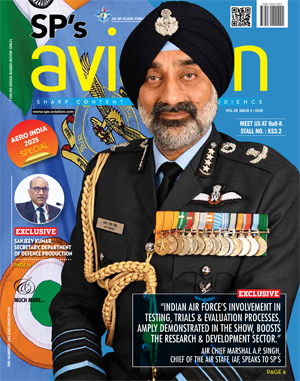INDIAN ARMED FORCES CHIEFS ON OUR RELENTLESS AND FOCUSED PUBLISHING EFFORTS
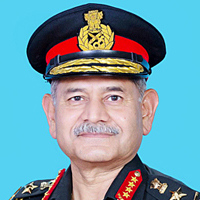
The insightful articles, inspiring narrations and analytical perspectives presented by the Editorial Team, establish an alluring connect with the reader. My compliments and best wishes to SP Guide Publications.
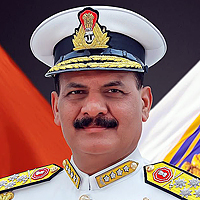
"Over the past 60 years, the growth of SP Guide Publications has mirrored the rising stature of Indian Navy. Its well-researched and informative magazines on Defence and Aerospace sector have served to shape an educated opinion of our military personnel, policy makers and the public alike. I wish SP's Publication team continued success, fair winds and following seas in all future endeavour!"

Since, its inception in 1964, SP Guide Publications has consistently demonstrated commitment to high-quality journalism in the aerospace and defence sectors, earning a well-deserved reputation as Asia's largest media house in this domain. I wish SP Guide Publications continued success in its pursuit of excellence.
EXCLUSIVE
A Legacy of Safety, Efficiency, and Innovation
Dassault Falcon Business Jets are redefining luxury and safety in Business Aviation. Carlos Brana, Executive Vice President Civil Aircraft, Dassault Aviation shares insights into the company’s vision and cutting-edge technology in an exclusive conversation with Jayant Baranwal, Editor-in-Chief of SP’s Aviation, during 2024 edition of MEBAA held in Dubai.
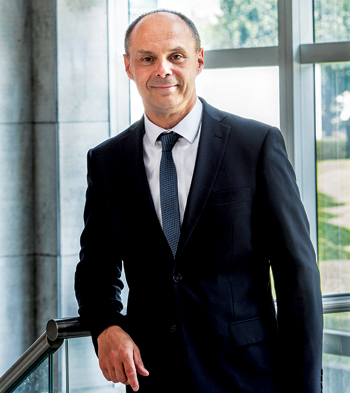
EXECUTIVE VICE PRESIDENT CIVIL AIRCRAFT, DASSAULT AVIATION
Jayant Baranwal (Baranwal): First of all, what are the very key features of Falcon family jets which make them different from any other jets in the world?
Carlos Brana (Brana): Well, let’s say that when the Falcon started, of course, one of the key features was safety. At the time, in the 1960s, 1963 actually, when we launched the first Falcon, a lot of people didn’t know very much what aviation was really, although they had the opportunity to fly, but, you know, there were a lot of accidents and so on. And so, our tradition was to make sure that the airplane was safe. The Falcon 20 was sturdy. Even, I would say, there is a story which happened in 1971, where there was a customer who bought a Falcon 20. And unfortunately, the airplane received bird strikes in its two engines. So, just at takeoff, and unfortunately, both the engine shut down. The airplane landed, but, you know, it did not land exactly as he wanted. So, the airplane broke, and that’s it. Except that the airplane was dead, not the passengers, neither the pilots, not the passengers, everyone was alive. At the time, it was just a little story, and thanks to that, the owner of the airplane said, OK, I will reorder one. That’s what he did. And, of course, there was an inquiry to understand what happened. And the people who made the inquiry were really surprised by the sturdiness of the airplane. So, at that time, they said, well, the airplane was flyable, sturdy, and this saved the lives of the people on board. True story! The point is that, with time, we have made progress to be more and more safe, and so on. And right now, we have the flight control system, which is the core of the safety of the airplanes. So, now we have the digital flight control system. This is one of the big features of the Falcon. Although, for example, the Falcon 900 and the Falcon 2000, they are not equipped with digital flight control system. They are more in the traditional flight control system, but they are very stable airplanes, very easy to fly, very easy to pilot. And thanks to that, they are deemed extremely safe. Actually, to be clear with you, we never lost the Falcon 2000, never lost the Falcon 900 and have never lost the 7X. So, all these airplanes, maybe we were lucky, but at least no incidents or no accidents, which led to the destruction of the airplane. So, it is to say, this is the thing we have been doing for years. The second point is about efficiency. What we have been doing for many, many years is develop efficient airplanes. Efficient airplanes is that you adapt, let’s say, the size of the engines to the size of the airplane. So, you design a very aerodynamic airplane with nice wings and so on, but also you adapt the thrust of the engine to the size of the airplane. If you have too much thrust, it’s nice, but on the other hand, your efficiency is not that good. For example, if you take a three-engine airplane, you have three small engines, and this is a very efficient airplane when it’s cruising. If you take two engines, a two-engine airplane will have bigger engines, because once you start to take off, if there is a fail of one engine, you still need to be able to take off with one engine. So, of course, you need to have the thrust for that. With a three-engine, if one engine fails, you still have two engines. So, you see the big difference. So, efficiency.
“To be clear with you, we never lost the Falcon 2000, never lost the Falcon 900, and have never lost the 7X. Safety has always been a core focus for us.”
Baranwal: But then why some of your jets are two engines, some of your jets are three engines?
Brana: Let’s say the point is also that the engines are more and more reliable. So, little by little, we looked at the global equation between the cost of the engines to the cost of the airplane, the maintenance cost of the engines and, of course, the maintenance cost of the airplane, and also the additional drag created by the third engine compared to the drag created by only two engines. We made a computation, optimisation and so on, and now we have to admit that two engines is okay. Although, it’s less frugal than the three engines. So, safety issue is always something you need to focus on and to take care of. But, we also understand that the people who are behind, they would like to fly comfortably. So, we have put more emphasis now on the comfort of the airplane. So, the level of noise, the amortisation of the plane or the dampening of the plane when you are in turbulences, the cabin pressure, the altitude, the cabin altitude, the ergonomics of the cockpit, how to fly better, the information you have in the easy flight deck, etc., everything is paramount to have a very, very nice airplane to fly. And so, the latest we are doing now, with the people getting bigger and taller, for the 6X and the 10X, we have now a bigger tube. The fuselage is a bigger diameter than it used to have. If you look at the Falcon 20, it’s very tight. And now, expanding with the Falcon, starting at 900, in the 2000, 7X, 8X, it is the same tube. 6X is a bigger tube and the 10X is even a bigger tube.
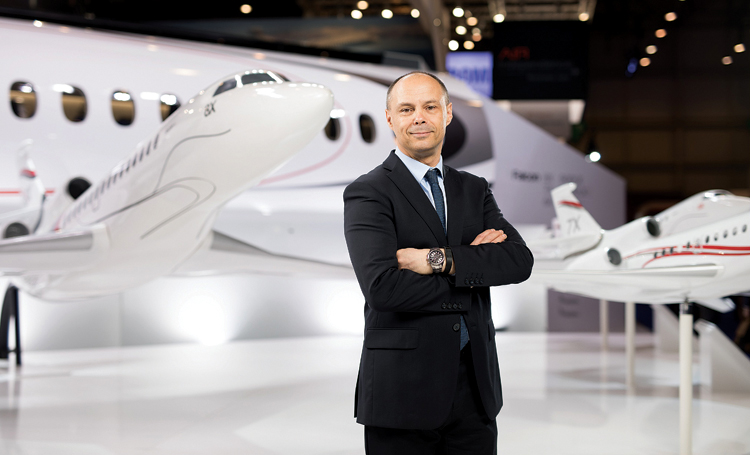
Baranwal: So, which one is the biggest?
Brana: The 10X will be the biggest. Today, the 6X is the biggest. And the 6X, I don’t know if you had the opportunity to visit it. But it’s the biggest cross-section of any purpose-built business jet. I mean, of course, it’s not bigger than the 777 or BBJ. But the BBJ is not a purpose-built business jet. And there is a big difference between a purpose-built and a non-purpose-built. Because when you are in a purpose-built, landings, in high altitudes, the performances are different. The cabin pressure is different. A lot of things are different compared to a non-purpose-built business jet. Even the ceiling to fly is different. So, we can go up to 51,000 feet. The ceiling for a non-purpose-built business jet would be maybe 41,000. That’s all.
“Business aviation is not only for the super-rich. It’s a tool—a flying office that saves time and creates opportunities.”
Baranwal: Tell me something about what enables you to take off a land on a short runway. And how short is the runway? What is the minimum size of runway you can work with?
Brana: We can certainly show you numbers. Typically, for example, a big 8X could land in 2,000 feet or even less. Of course, it depends on the weight and so on. The D.I.D., to have short landings, you have to have a decrease in speed at the time of landing. The way you can land with a slow speed, is based on the way we design the wings. So, we have in the wings the flaps and also the slats. So, actually, the wing is very straight when it’s cruising, and then when it lands, it’s distorted in order to increase the drag, but also the lift. And so, the speed is slower, and of course, the slower you land, the quicker is the slowdown. The brake acts much efficiently. And so, that’s the reason why we can have high performance in terms of landing on any kind of airport. By the way, other planes, some of them do not have the slats. And so their landing is much further. And in order to adapt to have a slower speed, they will have bigger wings. The whole stuff is a sort of compromise. Of course, when you have this kind of device, so flaps and slats, there is an additional cost to the airplane because you have to design and build mechanisms, sophisticated mechanisms, which allow the deformation of the wing at the time of the landing.
Baranwal: What is the story behind the name Falcon?
Brana: Initially, we started with the name was Mystère, mystery. Marcel Dassault, the founder of Dassault Aviation, saw there was a cartoon where the hero, the main character, was Dr. Mystère. Marcel Dassault seemed to like this Dr. Mystère, and when he had to name the plane, he called it Mystère. And the Mystère, of course, when you go to the United States, since the main market of the business aviation is in the United States, we had to Americanize the name, Mystère. And so, to be honest, I don’t know exactly what is the reason of this selection, but, you know, a traditional nice bird is a falcon, so we said, well, let’s call it Falcon.
“India is a country with immense potential and a growing business aviation culture. People are gradually recognising business aviation as a business tool.”
Baranwal: Well, business jets or private jets are perceived as only meant for rich and super-rich. Is this a correct expression?
Brana: So, there is sometimes a perception of business aviation which is different to what business aviation is really. We are in a segment where, yes, the market, let’s say the models, are certainly more expensive than others. But business aviation is not only for super-rich people. It’s also for people like you and me who are supposed to link from one town to another faster because there is no airline, there is no nothing. And so, the idea is sometimes to use small airplanes, sometimes with propellers, but they are not business jets, but they are business aircraft. And the majority of business aviation is linked to those kind of users. Actually, we represent in our segment a minority of airplanes. But it happens that some people, for example, they cannot be satisfied only with 500 kilometre range. They need a longer range airplane. Of course, they can afford that kind of range, that kind of airplane. But that also saves them a lot of time. If you think about the United States, for example, and it could be in China tomorrow. You know, a lot of big companies are located in remote areas because of large facilities. You have a lot of advantages being in remote areas, but the problem is how do you link between the remote areas to other parts of the United States or of the world. So, this is the reason why business aviation is a great link between towns which are not necessarily connected together. Plus, let’s suppose the President of a country or a Superstar wants to fly to a certain place. Imagine them going to an airport. If it happens, there is no more airport. Meaning the airport is completely blocked. All the other passengers will be stuck. For their own safety, sometimes it’s better that they go in a private jet rather than in the middle of the crowd. You never know what can happen. So, for those reasons, there is a need for business aviation. We can have debates about carbon emissions, etc. but a lot of things are, let’s say, better with business aviation. But just because the way we use this aviation, is something which is practical for some kind of people. In the United States, this mentality exists. Which means that people are willing to make deals, to perform, to get a better economy. The same message in Europe, or particularly in France, would be more difficult for people to understand. Also, it’s a cultural aspect. But they are right, you know, a lot of deals are made because you can have a face-to-face meeting with your counterparts. You know, close a deal and let’s go.
“Today, when internet connection doesn’t work onboard, some people refuse to fly. Connectivity has become so critical that we now talk about a true ‘flying office.’”
Baranwal: How do you find India as one of the upcoming markets?
Brana: So, India is, of course, a market with a huge potential. You know, 1.5 billion people almost. It’s a super big country compared to China or compared to the United States. It’s not that different in terms of size. No, India is, of course, a country with an immense potential. Now, you know, the potential is one thing and then the culture is another one. Everyone is not necessarily in tune with the use of business aviation because culturally they are not there. Now, what we see is that there is a growing market in India right now. And hopefully, you know, we will sell more and more and more. Let’s say, 20 years ago there was a market but not that big. So, people are coming little by little to business aviation as it is a business tool.

Baranwal: So, it’s a tool for you to do business. It’s a more efficient way. In other words, we can also say flying office or office in the sky.
Brana: To the point that, you know, when we are dealing with customers, one of their main problems is when the internet connection between the airplane and the rest of the world is different. This is something that they cannot stand. And it’s for good reason. You know, more and more people now are wanting the ability to perform their business while they are in flight. When we were flying an airline 20 years ago, you were watching movies or you were, you know, finishing your work and so on. But it was a more relaxing because there was no connection with the ground. But now everyone wants to be connected to the ground because they have a lot of interactions with their peers, with their families or whatever. And they need that connection. To the point today that when the internet connection does not work, some people, they refuse to fly. So, what we call AOGs, aircraft on the ground, are done, not because the airplane has failed, but because the internet connection has failed. But now, we have a revolution in the internet connection with the systems now, Star-link and so on, where the speed of connection of the internet is about the same as your own. So, you can be, in that particular sense, talk about a flying office. Because it is exactly like if you were in your office.
Baranwal: When are the 10Xs going to fly, going to be delivered?
Brana: We are working for a 2027 delivery. So, the entry into services will be 2027. And we start from there.
“The 10X is going to be a game changer. The range, the cabin volume, and the comfort—it’s like having a flying apartment with the brightness, noise control, and cabin pressure of a luxury experience.”
Baranwal: And have you started receiving the orders?
Brana: Yes. The 10X is going to be the best jet from the Falcon family in coming years? The big difference with 10X is the range and the cabin volume. We compare this not with our own airplanes, but to the competition. We think it will be a game changer! A game changer because the volume of the cabin is impressive. You will have a little apartment, let’s say, a flying apartment. It will be a like your old room with the same kind of surface of the small apartment. The people who are visiting the mock-up in Paris, you know, we brought the mock-up last year during the Dubai Airshow, they are very impressed by the cabin volume. Of course, we will make the airplane as comfortable in terms of noise, in terms of cabin pressure, brightness, etc. For example, right now, what we do is we have a cabin pressure which is about 1,200 meters. So, it’s about 3,900 feet. And for the 10X, it will be 3,000 feet. So, it’s about 900 meters. And the idea is that you feel the same, you have the same kind of air that you would have if you go to a mountain at 900 meters high.





